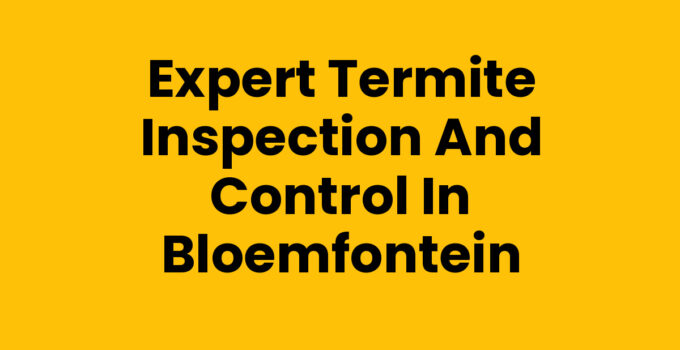Termites are often referred to as “silent destroyers” due to their ability to damage homes and properties without any immediate signs of their presence. If you live in Bloemfontein, the threat of termite damage can be significant given the region’s suitable climate for these pests. This blog post will help you understand the importance of termite inspection and control, and guide you through the necessary steps to protect your property from these wood-destroying insects.
Termite Inspection and Control, Bloemfontein: A Step-by-Step Guide
Conducting a thorough termite inspection and implementing an effective control strategy is critical for homeowners. Here’s a comprehensive guide to understanding this process:
Step 1: Understand the Types of Termites
- Subterranean Termites: Common in many regions, these termites live underground and are responsible for most of the damage caused to homes.
- Drywood Termites: Found in dry wood, these termites can infest homes without any contact with the soil.
- Formosan Termites: A very aggressive species that can rapidly damage structures.
Step 2: Signs of a Termite Infestation
Check for the following signs that might indicate a termite problem:
- Wood that sounds hollow when tapped.
- Sawdust-like material (frass) near wooden structures.
- Visible mud tubes on exterior walls.
- Swollen or blistered wood and flooring.
Step 3: Conducting the Inspection
A successful inspection should include:
- Interior Inspection: Start inside your home. Focus on areas like basements, attics, and places where wood is in contact with soil.
- Exterior Inspection: Check outside areas around the foundation, gardens, and logs stacked against the house.
- Hidden Areas: Look behind drywall and under floors—termites can be hiding in places you wouldn’t normally see.
Hiring a licensed pest control professional can greatly increase your chances of identifying an infestation early.
Step 4: Implementing Control Measures
Once you’ve confirmed an infestation, it’s time to implement control measures:
- Liquid Termite Treatments: Professional exterminators apply a liquid pesticide that creates a barrier around and beneath your home.
- Termite Baits: Bait systems use cellulose material mixed with a slow-acting insecticide, effectively killing termites over time.
- Wood Treatments: Special wood preservatives are available that protect your home’s wooden structures.
Step 5: Prevention Tips
Preventing future termite infestations is pivotal:
- Regular inspections: Schedule annual inspections by pest control professionals.
- Moisture control: Ensure there is no water accumulation around your foundations.
- Maintain wood-to-soil contact: Use concrete barriers and ensure wooden structures are isolated from soil contact.
Importance of Professional Termite Control Services
While DIY methods can be tempting, professional termite control services offer numerous benefits:
- Expertise: Professionals bring experience and specialized knowledge about termite behavior and treatment options.
- Advanced technology: Pest control companies often use advanced tools like thermal imaging and moisture meters that are not available to the average consumer.
- Effective long-term solutions: Professionals can implement ongoing preventative measures to protect your home beyond initial treatments.
Cost of Termite Inspection and Control in Bloemfontein
The cost of termite inspection and control can vary based on several factors:
- Size of the property: Larger homes may require more extensive inspections and treatments.
- Type of treatment: Different methods have different costs, and some might require ongoing treatment.
- Severity of the infestation: More significant infestations will typically require more intensive treatments, increasing costs.
On average, termite inspections in Bloemfontein may range from R500 to R2000, while treatment costs can vary significantly based on the method chosen.
In summary, termite inspection and control in Bloemfontein is essential for protecting your home from severe damage. Regular inspections and proactive measures can save you from costly repairs and ensure a pest-free living environment.
Frequently Asked Questions
How often should I have a termite inspection?
It is recommended to have a termite inspection annually to catch potential infestations early.
What are the signs of a termite infestation?
Signs include hollow-sounding wood, mud tubes, frass, and swollen wood surfaces.
Can I treat termites myself?
While some treatments are available, professional help is often more effective for significant infestations.



